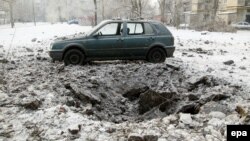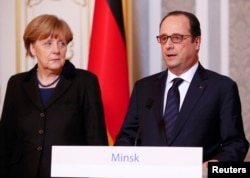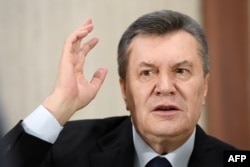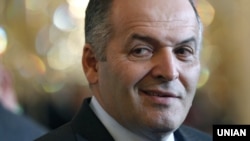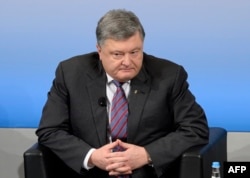KYIV -- It seems that peace plans for Ukraine are everywhere these days.
Amid a recent surge in violence in eastern Ukraine and yet another failed cease-fire in the nearly 3-year-old conflict are a wave of new proposals to bring peace to the crisis-stricken nation -- and from some unexpected places.
The Ukrainian Army has battled against Russia-backed separatists in the eastern Donbas region since 2014, with more than 9,750 people killed and more than 1.8 million displaced in that time, according to the United Nations.
More than 40 Ukrainian soldiers, separatists, and civilians have been killed in an uptick in fighting just since January.
The hostilities have continued despite an official peace deal known collectively as the Minsk agreements, the first of which was agreed in September 2014, followed by the second -- a reaffirmation -- in February 2015 by Ukraine, Russia, as well as the Moscow-backed separatists.
But the Minsk agreements have become unpopular and seem impervious to being implemented, leading to frustration and perhaps a reason for the flurry of new peace proposals.
Each new plan -- made by a mix of known politicians and shadowy operatives -- has sparked fierce debate in Kyiv political circles and among the Ukrainian public.
And the suspected motivations behind the peace offerings run the gamut, from personal ambition to a Kremlin plot to destroy Ukraine.
Balazs Jarabik, a nonresident scholar at the Carnegie Endowment for International Peace, told RFE/RL that he thinks the main reason for the peace plans seems to be to weaken Ukrainian President Petro Poroshenko, who remains in limbo between the increasingly disparaged Minsk agreements and "victory."
"Minsk is unpopular, peace is not. People are fed up with the war and the corruption [among government officials]," Jarabik said.
Some of the peace plans share similarities, while ideas in others seem to come from left field. Many of the news ones are far-fetched or wholly unacceptable to either Kyiv or Moscow.
In brief and collectively, they include:
-- Ukraine leasing the Russian-annexed Crimea to Moscow long-term, followed by a referendum to decide the Black Sea peninsula’s fate once and for all;
-- Temporarily setting aside the dispute over Crimea and Kyiv’s continued integration with the European Union and flirtation with NATO membership to focus on stopping the conflict in the east;
-- Reinstating elected officials from 2010 -- the last time nationwide elections included areas under the control of separatists -- and bringing in UN peacekeepers;
-- Allowing separatist leaders from the Donetsk and Luhansk regions to be included in Minsk negotiations with Ukrainian officials and reserving the option to hold a referendum on the status of the Donbas if Kyiv doesn’t fulfill its part of the Minsk deal;
-- Bringing back Viktor Yanukovych, Ukraine’s ousted ex-president living in self-imposed exile in Russia since 2014, to head a pro-Russian eastern region with more autonomy.
Here's a closer look at each of the plans:
The Minsk Agreements
The Minsk agreements offer a detailed, 13-point road map for settling the conflict. It begins with a cease-fire and the withdrawal of heavy weapons from the front line, which is currently monitored by the Organization for Security and Cooperation in Europe (OSCE).
After that is an all-for-all prisoner exchange, followed by local elections and an amnesty for fighters who haven’t committed heinous crimes. The sides are then to ensure the safe delivery of humanitarian aid and work toward the socioeconomic reintegration into Ukraine of the separatist-held territories.
Ukraine must also change its constitution to allow for the "decentralization" of its regions. In exchange, all "foreign-armed formations" -- for Ukraine, this means the Russian Army -- should leave and relinquish control of the border to Kyiv.
But these agreements were hashed out while Ukraine’s military was on its heels, forcing Kyiv to make several concessions. The Minsk agreements have also become unpopular because they have so far failed to bring a lasting peace.
The Kilimnik Plan
The most recent of the new peace plans came from Ukrainian-Russian political operative Konstantin Kilimnik, the one-time assistant in Kyiv to U.S. President Donald Trump’s former campaign chairman, Paul Manafort.
Calling his plan the Mariupol Plan after the southeastern Ukrainian city that is the largest in the Donetsk region controlled by the government and which sits smack against the front line -- Kilimnik envisages it replacing the current Minsk agreements and Normandy format talks between Ukraine, Russia, Germany, and France.
Despite his connection to Manafort, who lived in Ukraine and worked as an adviser to Yanukovych for years, Kilimnik emphasized that the American strategist has had no part in this plan, which he says remains fluid.
The plan, he said, was raised by "many people who are willing to start [a] dialogue" between eastern Ukraine and the rest of the country "and this should be one of the roles of the Opposition Bloc and other opposition parties, which understand the necessity of bringing Donbas back into Ukraine." The Opposition Bloc is the revamped, pro-Moscow political faction once called the Party of Regions and led by Yanukovych.
Right now, there is no dialogue between Ukraine and the leaders of the separatist-held areas, Aleksandr Zakharchenko and Ihor Plotnitsky. Kyiv considers them "terrorists" and Kilimnik said they "have blood on their hands, [so] it will be very difficult for Poroshenko and others to negotiate with them."
However, "in theory, a figure representing Donbas, such as Yanukovych or someone else who has at least not killed people and can stop the war and fix the local economy, might be an option," Kilimnik explained.
Many Ukrainians, though, believe the former president’s hands are dripping with blood as they hold him responsible for the deaths of more than 100 protesters shot by riot police during the Euromaidan protests in Kyiv in 2014. Ukraine has charged Yanukovych with treason -- an allegation he denies.
Peace in Ukraine "is up for Ukrainians to figure out, and the only way to proceed is a national consensus and dialogue," Kilimnik said.
The Yanukovych Plan
Yanukovych, in an interview with a group of Western reporters on February 21, shared his own 10-page proposal, which he said he has sent to Trump and the leaders of Russia, Germany, France, and Poland, according to The Wall Street Journal and Der Spiegel.
Der Spiegel said the plan has six points leading to a resolution of the conflict.
"Four relate to the 'investigation into the crimes committed on the Maidan in February 2014,' for which he proposes a special commission to be established by the Council of Europe," the German news outlet reported.
Yanukovych also called for the separatist leaders in Donetsk and Luhansk to be included in negotiations with Ukrainian officials. The sixth point outlines a plan for a referendum to be held on the status of the Donbas if Kyiv doesn’t fulfill its part of the Minsk deal.
The Artemenko Plan
Another peace plan has caused a scandal in Washington and Kyiv.
This one, proposed by Ukrainian lawmaker Andriy Artemenko, is the most detailed and is believed to have landed on the desk of Michael Flynn, who resigned as U.S. national security adviser on February 13 after alleged misleading statements about conversations with the Russian ambassador in Washington in December.
The New York Times, which broke the story about the plan, cited Artemenko as saying it had been approved by top aides of Putin -- but the Kremlin on February 20 quickly denied any such tacit approval.
The plan calls for a "compromise," such as holding a national referendum on leasing Crimea to Russia. Artemenko told The New York Times the lease should be for a period of 50 to 100 years, but he told the Strana.com news site the plan suggests a lease for 30 to 50 years.
"At the expiration of this period, in Crimea, a referendum will then be held and monitored by international bodies, on which finally the question of the peninsula may be solved," Artemenko told Strana.
Artemnko’s plan calls for the return of territories controlled by Russia-backed separatists to Ukraine and an amnesty to all involved on the separatist side "except those who have committed the most serious crimes."
He said control of the Ukrainian side of the border with Russia must be returned to Kyiv, but not before a safe corridor is provided for 72 hours for those who would prefer to live in Russia.
After that, Artemenko said, the plan calls for a nationwide referendum on whether to grant the eastern regions a special autonomous status. If approved, the next step would be to begin revitalizing the regions with funds from the lease agreement with Russia.
Once all of that is done, he said, then sanctions against Russia could be lifted.
Both Ukraine and Russia rejected the conditions in this deal and Crimean prosecutors even opened a "treason" case against Artemenko over the issue.
Since the revelation and the inquiry, Artemenko has denied ever passing such a plan to Trump officials and threatened to sue The New York Times in New York for libel.
The Taruta Plan
Serhiy Taruta, the Ukrainian billionaire industrialist and former governor of Donetsk, proposed at the end of January his "three principles" plan to restore legitimacy, security, and trust.
It calls for reinstating the last legitimately elected Donbas officials from 2010 and appealing to the international community to recognize them. A UN peacekeeping contingent would keep the region secure while those officials work to reintegrate it with greater Ukraine.
The plan has largely been ignored by the greater Ukrainian public, but Taruta continued to push it during the Munich Security Conference last week.
The Pinchuk Plan
Billionaire oligarch Viktor Pinchuk caused a stir in Kyiv when he proposed a plan in an op-ed in The Wall Street Journal in late December.
The article was headlined: Ukraine Must Make Painful Compromises For Peace With Russia, and the plan laid out in the paper suggested that Kyiv set aside the issue of Crimea and hopes of European Union and perhaps even NATO membership in exchange for peace in the Donbas.
"We should also make clear that we are ready to accept an incremental rollback of sanctions on Russia as we move toward a solution for a free, united, peaceful, and secure Ukraine," Pinchuk wrote. "The Ukrainian lives that will be saved are worth the painful compromises I have proposed."
Mustafa Nayyem, a lawmaker and vocal critic of the proposal, said in doing this that "we will not save thousands of lives, but with our support and recognition, doom millions of people to legalized slavery."
Kyiv’s Stance
Ukrainian President Poroshenko and top officials have thus far been resistant to or else have condemned each of the proposed plans, saying the Minsk agreements are the only pathway to peace for the country. Western leaders have thus far agreed.
Against this backdrop of confusion, analyst Jarabik suggested, Ukraine risks becoming even more unstable.
"All these internal struggles will weaken Ukrainian unity and may lead to [early] elections, but the fault lines will not go away," he said.




